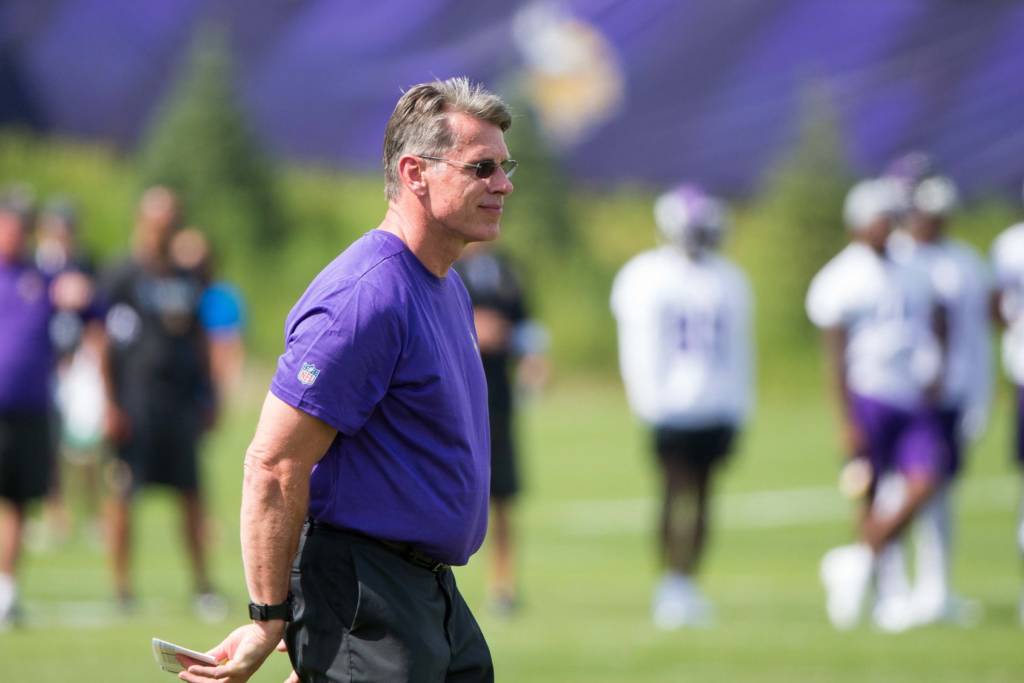Rick Spielman does it again.
The Minnesota Vikings made a draft-night trade, moving the 14th-overall pick and the 143rd pick in exchange for the 23rd, 66th, and 86th picks from the New York Jets. The Jets then selected offensive guard Alijah Vera-Tucker from USC with their newly acquired 14th pick. Minnesota took a chance on trading back and hoped nobody else would snap up the player they were targeting, and they lucked out. Christian Darrisaw of Virginia Tech, who many thought was the right player to take at 14, was still available at 23.
Rick Spielman looked like a genius.
While this high-wire act was effective, not every trade up or down in the NFL Draft pans out. Think of when the Cleveland Browns traded with the Vikings to take Trent Richardson and missed out on Matt Kalil in 2012. Even though specific roster needs significantly factor into which player a team drafts, there is an inherent risk in trading both up and down.
When trading up, you are susceptible to overpaying for a player. According to ESPN, “There have been 25 trades up for a first-round QB involving solely draft picks, and in all 25 instances, the team trading up overpaid, strictly in terms of draft pick value, according to ESPN draft pick valuations. Six of the past 12 teams to move up have overpaid the equivalent of a first-round pick.” While this is specific to quarterbacks, teams tend to give away the house when trading up into the top 10.
Conversely, when trading down, most teams know who they want and expect them to still be available after they move back. More often than not, they gather additional capital for later in the draft. However, there is a scenario where trading back could’ve really hurt the Vikings. If the New York Giants had taken Kwity Paye (a defensive edge player they desperately need) instead of Kadarius Toney, the Indianapolis Colts would have likely taken Darrisaw instead of Paye and the Vikings would have been stuck at 23 without a lot of options.
But the Vikings made out like bandits, picking up one of the best offensive linemen in this draft while watching other teams jump on linemen who may have been picked too early (think the Las Vegas Raiders taking Alex Leatherwood earlier than most analysts expected at 17th overall). Minnesota took a quality player and picked up more value along the way — a wise move all around.
Gaining draft capital would have allowed the Vikings to move up into the second round for their QB of the future. But they didn’t need extra picks to do so, given that they already had two third rounders coming into the draft. Then, after receiving two additional third rounders from the deal with the Jets, they still didn’t trade up.
Instead, they decided to stand pat and draft Kellen Mond in the third round. With Kyle Trask being taken late in the second round by the Tampa Bay Buccaneers, the Vikings’ front office must have seen the writing on the wall and knew the available QBs would go quickly. Spielman could have traded back into the second round to pick up an offensive lineman or a defensive player, but he opted to hold on to his draft capital and read the board correctly. He got his quarterback and was able to pick three other players in the third round after him.
Who knows, maybe the Vikings’ front office reached out to package some of those picks and were turned down. Either way, it looked like a foregone conclusion to move up and take the likes of Asante Samuel Jr., the cornerback from Florida State, or linebacker Nick Bolton from Missouri. There even appeared to be an opportunity to move just a few spots up into the late second round and pick up Trask.
This looked like a good opportunity to capitalize on some players sliding into the second round, and Minnesota may have missed the boat. Spielman wasn’t sold on the players available in later rounds of the draft and still didn’t move up to capitalize on higher-value players in Round 2. Given Spielman’s success in the second round — Sidney Rice in 2007, Phil Loadholt in 2009, Kyle Rudolph in 2011, and Eric Kendricks in 2015 — it seems like moving into the second round was a given. The team definitely capitalized on value in their first-round trade but shied away from the moment throughout the second and third rounds.

